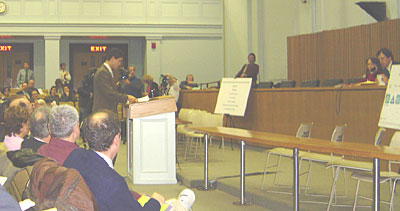December 14, 2004
Transportation commitments public hearing summary
Today at the State House, the Executive Office of Transportation (EOT) and the Department of Environmental Protection (DEP) led a public hearing on the remaining transit commitments, including the Green Line extension. Their goal was to get feedback on the proposed process to re-evaluate these commitments. But the 300 or so people attending the hearing didn't let them get away with that. Instead, person after person spoke out that these commitments should be honored as-is, not re-visited or re-evaluated.

State Senator Jarrett T. Barrios addresses the panel
Proposed Process for Re-Evaluating Commitments
In the first 30-40 minutes of the hearing, a proposed process was described that would re-evaluate the three remaining Big Dig air quality mitigation transit commitments. This process is outlined below.
1. DEP sets air quality goals for any projects, which must meet or exceed the goals of the current commitments.
2. EOT and MPO evaluate possible projects that would meet these air quality goals. The current commitments are evaluated alongside any proposed substituted projects. Projects are evaluated according to criteria shown below.
3. Public hearings are held on the project evaluations.
4. EOT and MPO propose final projects (e.g., the substitution for the Green Line extension).
5. DEP holds public hearings and approves revised projects. Submits changes to federal EPA.
6. EPA reviews and approves projects.
7. MPO holds public meeting to announce new projects. The 25-year Regional Transportation Plan is amended to include them.
Criteria for Re-Evaluating Projects
These are the statewide criteria for all highway and transit projects.
Utilization - The "user benefit" to customers in terms of average travel time, system reliability, and transfers.
Mobility - Expansion of transit access to areas that are underserved
Cost-Effectiveness
Air Quality
Service Quality - Safety, station access, comfort, and customer information
Economic and Land Use Impacts
Environmental Justice - serves minority and low-income customers

